Pearsonville: Hubcap Capital of the World
On a bleak and barren stretch of remote U.S. Highway 395, Andy and Lucy Pearson founded Pearsonville, California. It was 1960 and the small family had just moved to their recently purchased forty-acre tract of empty high desert land with plans to start a business servicing motorists. Living in a drafty two-room shack, they built a roadside cafe, with an attached apartment, as quickly as possible.
The run up this stretch of isolated highway was grueling. The long, gradual grade from the Southern California lowlands into the scorching-hot upper Mojave took its toll on the cars of the day. It quickly became clear that Andy and his teenaged son, Don, would be spending most of their time towing and repairing the cars of stranded motorists. By the mid-‘70s, Pearson’s was a thriving operation, with the beginnings of one of the largest wrecking yards in the region. What was nothing but creosote scrub desert only fifteen years before had become a full-fledged town, appearing on roadmaps and regional highway signs.
After two tours of duty in Viet Nam as a Navy Seabee, son Don returned to Pearsonville and took on more of the family business. He expanded it even more, increasing the size of the towing fleet and opening another yard and recycling facility in Ridgecrest, twenty miles to the south. Ever the entrepreneur, he built and operated a quarter-mile dirt racetrack on the North side of the now sprawling, 4,000 car junkyard. The “Pearsonville Raceway” saw wild action on Saturday nights for almost fifteen years, attracting racers from all over the state.
In the ‘80s, Andy retired, selling out to Don. Lucy, a Pearsonville fixture since the very beginning, took an interest in collecting hubcaps. It became an obsession for her and she amassed thousands of them. From numerous television appearances on shows like To Tell The Truth and Travels with Harry Smith, “The Hubcap Queen” and her collection became well known all over America. Pearsonville became the “Hubcap Capital of the World.”
Splitting his time between his businesses in Pearsonville and Ridgecrest, Don’s empire flourished and his own son, David, began to participate in the family business. They opened a modern, corporate truck-stop and gas station complex on the south edge of Pearsonville in the late-‘90s, shutting down the original, ‘60s vintage, gas station, repair shop and cafe. By then, most of the family’s wrecking and salvage business had also moved to the more centrally located Ridgecrest yard.
When Don suddenly died in 2006, the entire family enterprise fell on David’s shoulders. Plate already full with the Ridgecrest operation, the distant Pearsonville yard became even more difficult to justify keeping open. Within a year, thousands of cars were either sold off or moved to the Ridgecrest yard for storage and the structures fell into disrepair. Aside from the busy truck-stop at the off-ramp, Pearsonville was fast becoming a ghost town.
The Serial Trespasser
This was the state in which I found Pearsonville when I arrived on the scene in 2008. Another photographer I know had explored the perimeter of the now mostly abandoned yard and found a cross-country, back-way in. He shared his recon info with me and said it was one of the best junkyards he’d ever seen. On my next trip to the region, I hiked in at 1AM, after shooting a nearby ghost town. What I found blew my mind. While thousands of cars and trucks had already been moved out or sold for scrap, there were still approximately 1,000 vehicles inside the fence. The collection that remained was a deep cross-section of every American marque from the 1950s through the ‘70s, mutedly gleaming under the chilly March full moon. I had stumbled into an elephant’s graveyard of amazing and rare Detroit iron.
That first night I arrived too late to do much except explore one small section of this enormous site with my jaw hanging open. I rearranged my plans for the rest of that trip, booked an extra night in my motel in Ridgecrest and hiked into the yard the next night, shooting and exploring for 8 hours. Having still only scratched the surface of the site’s potential, I spent two of the next three full moon phases there, driving 800 miles, round trip, to the high Mojave, specifically to photograph this amazing collection of vehicles. I slipped in the back way under the cover of darkness a total of six times, a serial trespasser.
For more on “The Pearsonville Experience” visit the Pearsonville 2009 set.
For more on the fate of Pearsonville, visit the Pearsonville 2010 set.
























































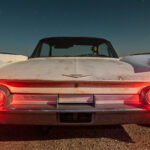













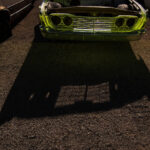

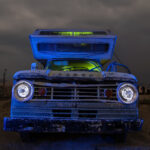


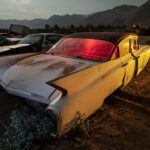

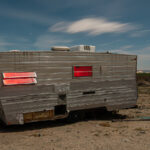
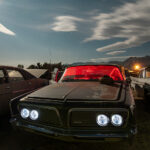















Trackbacks/Pingbacks
[…] is some more info. Pearsonville 2008 | Lost America I drove by this location 4 times in my work travels, never knowing what was there. I am going to […]